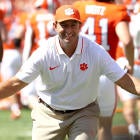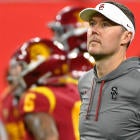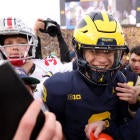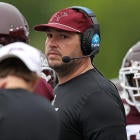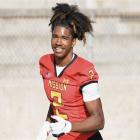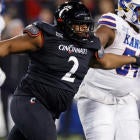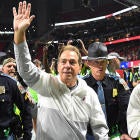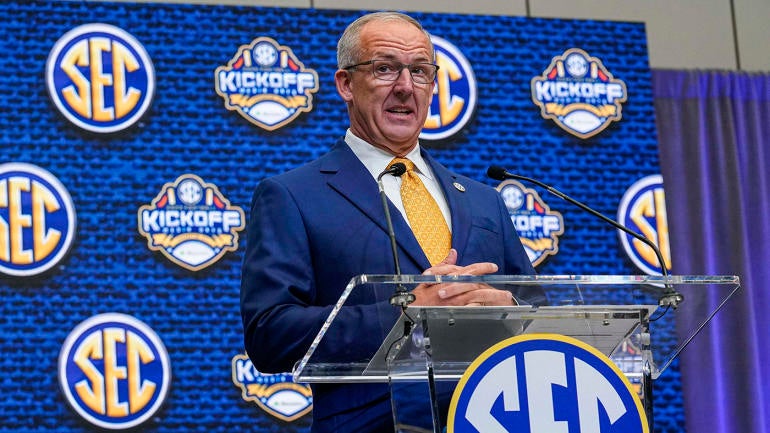
DESTIN, Fla. -- Memorial Day is not a work day, but on the eve of the SEC's spring meetings, it was clear commissioner Greg Sankey was more interested in getting back to work Tuesday to seek feedback from his conference's leaders and not necessarily face a litany of questions that do not yet have answers.
"I'll be happy to do my best to dodge every question you ask," he joked, eliciting a laugh from a small contingent of reporters.
An understandable introduction? Perhaps. The $2.8 billion settlement announced last week in the House v. NCAA case, a landmark legal battle, has far-reaching implications anchored by revenue sharing and the expansion of roster sizes, which might also spark more legal battles with Title IX and antitrust implications. The amateurism model is dead, blown up after nearly one year of negotiations among the power conferences, the NCAA and the House's counsel.
Publicly, the time to begin formulating resolutions based on the settlement terms begins this week in the large ballrooms at the Hilton-Sandestin, where the first major conference will conduct its annual business meetings in the wake of last week's seismic news.
"I anticipate plenty of conversation here with our leadership about what that means for our own decision-making," Sankey said. "We have the opportunity to play an important role in our own decision-making about the future, as opposed to leaving that just to the court system."
The settlement terms are complicated and developing models will take time. Terms could change, too, as nothing is settled until Judge Claudia Wilken of the U.S. District Court for the Northern District of California rules whether to accept the terms -- potentially within the next 60 days. From there, it would take several months for everything to be finalized.
"We're not in any aftermath," Sankey said. "We are in that process. Still, that process will be months. In fact, many months ahead of us, subject to court review, subject to an entire legal process."
So, what are Sankey's ideas? He didn't share much Monday, though he at least toed a hard line on the discussion of treating athletes as employees.
"I've not had a student-athlete come to me and say I want to be taxed like an employee," Sankey said. "There are those who advocate for that reality. That takes me back to a fundament statement, which is there's no better time to be a student-athlete than right now in the history of college sports -- no better time. They're not calling me and saying, 'I want to be an employee, I want to be taxed like an employee.' Those rights advocates, they have freedom of movement, freedom to NIL, it's a pretty good existence. And we ought to be careful to try to honor that when we think through better ways to support our student-athletes in a national, competitive structure."
And that's a core tenant for the House settlement. Congress has tried and failed to create NIL legislation more than one dozen times over the last three years. Lawmakers have asked the NCAA and college leaders to provide a blueprint and clarity on the future. Sankey and other conference commissioners have worked to educate legislators on the issues in hopes it'd ultimately lead to something tangible. Over the last year, influential lawmakers like Sen. Ted Cruz have offered optimism that a solution was possible -- Cruz put it at 60-40 in October that Congress would pass a NIL bill -- but the SEC's top official admitted on Memorial Day that it is increasingly unlikely, even after the House vs. NCAA lawsuit settlement terms were agreed to, that any federal solution will be coming before November's presidential election.
"This is a national system that deserves national standards, not just state by state, whether it's legislative action to determine rules or Attorney General action to determine rules," he said. "We need national standards. And that's the role that Congress plays."
As for how a revenue-sharing model should be structured? Sankey didn't share any ideas, nor did he offer a big statement on whether he's for or against sharing the bulk of revenue with football and men's basketball players, much like backpay for athletes will be handled in the House settlement.
"Our trends have been to provide some equity," he said. "This is a very different world. I expect we'll elicit opinions, perspectives, and we've got time to learn those perspectives. And then we're gonna have to work through what that means from a decision-making standpoint."
Can the NCAA's desire to develop stronger rules governing name, image and likeness collectives have teeth? Should collectives still exist in the new model?
"We'll see," he said.
And what about unlimited scholarships outlined in the settlement? In connection, Sankey made it a point Monday to clarify the creation of new roster limits is "just a concept," rather than a formality. The issue of roster sizes has been a topic in coaching circles for several weeks across the country, and it has elicited strong opinions from coaches as ideas from closed-door meetings leaked in the media.
Yahoo Sports first reported a roster limit of 85 players, all on scholarship, would eliminate all walk-on players. The idea of eliminating all walk-on players naturally fired up college football coaches who pushed back, publicly and privately, about the concept.
The topic is expected to get considerable discussion at the SEC spring meetings, but Sankey has already tried to preach patience to his coaches when it has come up in recent weeks.
"I've not talked to our coaches about that other than individually to say, 'Hey, slow down, guys,'" Sankey said. "... I think it's a bit of a threat, a danger that we can't have a conversation about concepts that don't populate themselves outside the room. So then that provokes a reaction. I know other conferences have discussed it, coaches have then texted our coaches. They get fired up and we said, 'Just wait, we're gonna have a conversation.' That's where it is."
Sankey not a fan of Rashada lawsuit
Sankey weighed in for the first time Monday on the bombshell Jaden Rashada lawsuit that accused Florida head coach Billy Napier, among others, of fraud over a failed $13.85 million name, image and likeness deal. Napier has yet to publicly comment on the lawsuit himself.
"I'm not a fan of lawsuits," Sankey said. "That's what I think."
The Georgia quarterback filed the lawsuit last Tuesday in federal court accusing Napier, top booster Hugh Hathcock and former Florida staffer Marcus Castro-Walker of fraudulently inducing him to pass up on an alleged $9.5 million offer to go to Miami to instead sign with Florida with no intention of following through on a $13.85 million promise. The lawsuit alleged that Napier personally vouched to Rashada that Florida alumni "were good on their promise that Jaden would receive $1 million if he signed with UF on National Signing Day"' and that Hathcock would make the payment.
After Napier's alleged financial promise, Rashada signed with Florida during the early signing period in December 2022. He was let out of his letter of intent the following month after the NIL deal fell apart, and it became clear he would not receive the promised payments.
Rashada spent a single season at Arizona State in 2023 before transferring to Georgia in the spring. That move heightened interest in a historic lawsuit pitting a current SEC student-athlete against a rival SEC head coach.
"Not the only lawsuit involving a coach over the last year, won't be the last," the SEC commissioner said. "We have a legal system and people have a right to pursue what they view as grievances and the legal system serves that out."
SEC to discuss injury reports
The SEC may soon follow the Big Ten's lead and begin providing player availability reports for its major sports, including football and basketball. Sankey said discussions with the SEC's senior leadership began last summer and will be expanded to include coaches and athletic directors this week. A decision will not be made in Destin.
"We have to be thoughtful about how information is managed," Sankey said. "It's also a reality that the lives of young people in colleges versus the lives of professional athletes are very different, a lot more exposure to people."
Future football scheduling model on backburner
The SEC still has a decision to make on whether to move from an eight- to nine-game conference schedule in football starting in 2026, but just don't expect one this week. The fallout from the House settlement will dominate conversations at the SEC's spring meetings, Sankey said.
Kick times, TV designations coming
On Thursday, the SEC will release kickoff times and TV networks for several games in the first three weeks of the 2024 football season.
"There'll be some other games in there and a few surprises probably for the season ahead," Sankey said.
Some matchups, however, will remain off limits as part of six- and 12-day window selections to best feature high-profile games.
The entire early-window kickoff games (11 a.m. through Noon) will be revealed by mid-June, Sankey said, which is a change from past practices as the SEC begins its first year under a single media agreement with Disney rather than with CBS and Disney.








